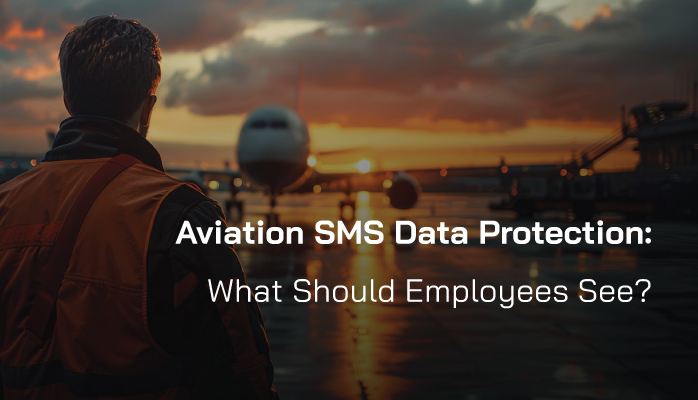What Is Safety Transparency in Safety Management Systems

Safety transparency is a big deal in aviation safety management systems (SMS). On one hand, employees need protection from managerial reprisals and negative peer pressure when self-reporting errors and mistakes. On the other hand, employees are genuinely interested in learning what dangers lurk in the workplace and how to avoid these dangers.
How much safety information should be shared?
Does a safety culture truly benefit when all employees can access all safety data, such as:
- Reported safety issues; and
- Identified audit findings?
As an aviation SMS database provider, one of the most frequent questions we receive is "How should we set up roles, permissions, and access to safety data in our aviation SMS database?" In every case, safety managers are weighing the pros and cons of having a transparent safety culture while also protecting the company against future fallouts.
Transparency is how you define access to such data based on employee roles in your aviation SMS implementation.
Related Articles on Aviation SMS Transparency
- A Key to Transparency in Aviation SMS
- How to Practice Safety Transparency and Just Culture in Aviation SMS
- Privacy, Transparency, and Confidentiality in Aviation Safety Management
Important Elements of Transparency in Aviation SMS
Here are the important elements of transparency:
- High transparency is generally considered to provide a high degree of access to all employees;
- Low transparency is generally considered to provide a high degree of access only to select managerial roles on a "need-to-know" basis;
- Transparency and aviation safety culture have a high degree of correlation; and
- Once employees can see all safety issues (transparency), it’s impossible to take that privilege away without enraging employees.
In simpler terms, transparency comes down to “who knows what” and “how much they know.” Transparent safety cultures:
- Give all employees high latitudes of access to safety data;
- Do not restrict relevant information except in rare cases; and
- Employees have access to managerial safety issues.
Non-transparent safety cultures:
- Restrict employee access to most safety issues;
- May only provide a very general summary of reported safety issues; and
- Have very strong top-down control of safety communication/information.
While non-transparent cultures look rather undesirable, “non-transparent” does not always mean “worse.”
The Truth About Transparency in Aviation SMS Implementations

The hard truth that people don’t seem to want to say out loud is that transparency doesn’t always make sense. In many organizations, employees shouldn’t see all reported safety issues in their aviation SMS database. Why?
- Because transparency has the potential to do more harm than good to maturing aviation SMS implementations.
Consider a company with a safety culture in which employees:
- Practice passive aggressive retaliation;
- View “reporting safety issues” as “ratting-out” or betraying; and
- Encourage each other to “deal with things under the table.”
As you may be all too aware, these scenarios are not uncommon. In such hostile cultures, not securing reported safety data will only result in:
- Peer and/or managerial retaliation; and/or
- Lack of reporting to avoid drawing attention to oneself.
Related Aviation Safety Reporting Articles
- How Confidential Aviation Safety Reporting Systems Offer Assurance to Employees
- 5 Simple Tips to Improve Aviation Safety Reporting Cultures
- How to Develop Healthy Safety Reporting Cultures in Aviation SMS
Managerial Trust and Transparency Require Time
In hostile organizations, transparency will need to be cultivated slowly. Think about "baby steps." Over time, such companies can work towards having a high degree of transparency but will first need to develop Norms and trusting hazard reporting cultures. Unfortunately, some organizations also use these discussion points as excuses for not developing a transparent safety culture, when in fact they would rather not give up “control” of information.
In general, we see high degrees of transparency in these two scenarios:
- Brand new SMS implementations with employees possessing strong inter-personal relationships; and
- Mature and reasonably compliant SMS implementations that can focus on developing a safety culture.
In hindsight, both of these scenarios are easy to identify. In fact, they are so very obvious that they may not even be evident to the accountable executive and the safety team until an event occurs that requires them to evaluate their safety culture and employees' unfettered access to safety information.
Two Examples of Trusting Safety Cultures
The first scenario occurs in a new SMS implementation.
Management is excited about the new SMS and they are spreading their excitement to all employees. This "new SMS initiative" will be different from the traditional, legacy "safety program." In the traditional safety program, there were no managerial accountabilities. In fact, very many traditional safety programs existed solely on paper and upper management seldom participated in related safety events.
With the new SMS implementation, management promises that transparent safety communications and employee involvement in the "SMS processes" is the new way of doing business. Employees (from trusting organizations) will have no reason to distrust management and will eagerly participate. As long as management does not violate employees' trust in the SMS, all will be well. Regular safety promotion campaigns will continue to develop the safety culture and the SMS will naturally mature.
The second scenario begins with a "normal company" where employees may not so easily "drink the Kool-Aid" and fall into alignment with the SMS rhetoric for a brighter, safer tomorrow. This scenario is very typical:
Management tells the employees that they are implementing a formal aviation SMS. These employees have seen the results of their traditional safety program where employees may submit safety reports, but nothing ever changes. There is no visibility into the safety processes and management has no accountability for the safety program. This is a very common phenomenon.
As time passes, employees are being included in the risk management decision-making processes. Safety meetings are regularly attended by top-level executives and employees slowly become safety converts. Regular safety promotion campaigns include comments and motivational messages coming from the top down. Employees are not left wondering whether management values their inputs because employees will have visibility into the SMS' risk management processes.
Each of these scenarios can be considered a "win" by management. In both cases, the aviation SMS didn't succeed overnight. Time, personal commitment to the SMS, and managerial trust are all required for successful safety cultures. Both types of companies represented by these examples are predisposed to share safety data with the expressed purpose of promoting their safety cultures and maximizing their aviation SMS investments.
Related Aviation Safety Culture Articles
- What Is Safety Culture in Aviation Risk Management
- 5 Components of Safety Culture in Aviation SMS – With Examples and Resources
- Examples How to Improve Safety Culture in Aviation SMS
How Do Most Organizations Treat Transparency
Most aviation service providers have very low levels of transparency. They do not allow employees to see submitted safety reports that other employees had previously submitted. Most organizations will periodically release desensitized data with limited information about reports. Yet, as a rule, safety information is highly guarded, almost as if management fears that employees will misuse the safety data or leak information that paints the organization in a less-than-favorable light.
Is this bad? As discussed, of course not. This is simply a strategy most organizations use to develop their SMS implementation while also protecting their brand or reputation. The logic is this:
- Get employees comfortable with basic principles of SMS implementation first;
- Engender trust between management and detail employee protections against the use of reported safety data (supported by the non-punitive reporting policy);
- Build a hazard reporting culture by constantly highlighting employee protections and abiding by these protections; and
- Gradually provide more and more access to reported safety information.
Not everyone will agree with the above approach, citing that the best time to start introducing a transparent safety culture is now – there will never be ideal conditions for transparency. It’s up to each organization to assess which approach is the most effective.
Most importantly, organizations need to be honest about whether they are practicing undue control, or whether it really is in the best interest of employees to have more data access. The argument for improved safety reporting metrics is very compelling.
Why Employees Shouldn’t See All Reported Safety Issues

Employees shouldn’t see all safety reports when an organization has other, more pressing priorities. If you are wondering, should employees see all safety reports, here are some examples when the answer would be NO in every SMS implementation:
- High degree of non-compliance that needs to be addressed immediately;
- High employee and/or management turnover;
- Behind on closing safety reports per policy;
- Behind on aviation SMS implementation; and
- Poor safety culture, Norms, etc.
Such examples demonstrate situations where there are more important and immediate needs for developing the SMS implementation than developing a more transparent safety policy.
Oddly enough, aviation service providers struggling with any of the above scenarios will have issues that must be dealt with at the upper end of management versus focusing on the lower echelons. Aviation SMS implementations are driven from the top down. Safety culture issues at the bottom of the organization betray managerial issues at the top. This is a very important point.
Stagnating and toxic safety cultures don't happen overnight. After all, employees are being trained and shown what is acceptable from the cues given by upper management. An astute safety manager will understand this point and will look both up the chain of command as well as down when evaluating their safety culture. After all, the safety manager needs both managerial support as well as line-level employee support to succeed.
Related Aviation Safety Management Articles
- Why Aviation Safety Managers Fail Without Dept Head Support in SMS
- How to Earn Top Management Support for Aviation SMS
- 2 Reasons Top Safety Managers Fail in Aviation SMS
Final Thought: When Employees Should See All Issues
Long story short, organizations should develop a more transparent safety policy and allow employees to see all safety issues when:
- Management has the time and resources to maintain positive transparency;
- Such transparency can be safely maintained; and
- Usually, towards the beginning or end of implementation.
Letting all employees see most safety issues backfires when management is not able to take the Safety Promotion steps to keep such transparency positive. In such events, the SMS implementation's safety performance metrics can grind to a halt as employees stop reporting issues and/or turn against each other.
A fantastic way to justify your transparency policy is to create a manifesto. You might have line items for things like "We are dedicated to having a high degree of transparency," or, "We are dedicated to keeping your safety concerns private and safe." Here is a manifesto that will be extremely valuable to do this.
Last updated in January 2025.








